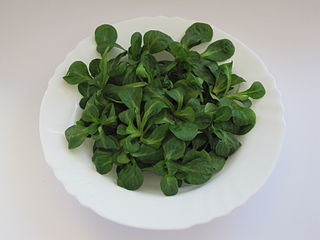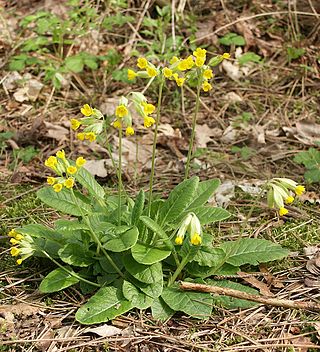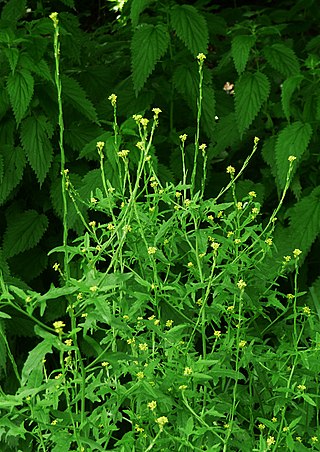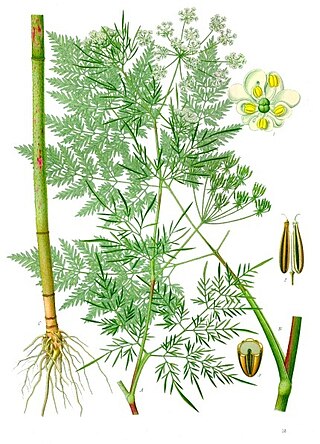
Tropaeolum, commonly known as nasturtium, is a genus of roughly 80 species of annual and perennial herbaceous flowering plants. It was named by Carl Linnaeus in his book Species Plantarum, and is the only genus in the family Tropaeolaceae. The nasturtiums received their common name because they produce an oil similar to that of watercress.

The chestnuts are the deciduous trees and shrubs in the genus Castanea, in the beech family Fagaceae. The name also refers to the edible nuts they produce. They are native to temperate regions of the Northern Hemisphere.

Root vegetables are underground plant parts eaten by humans as food. In agricultural and culinary terminology, the term applies to true roots such as taproots and tuberous roots as well as non-roots such as bulbs, corms, rhizomes, and stem tubers.

Vigna subterranea is a member of the family Fabaceae. Its name is derived from the Bambara ethnic group. The plant originated in West Africa. As a food and source of income, the Bambara groundnut is considered to be the third most important leguminous crop in those African countries where it is grown, after peanut and cowpea. The crop is mainly cultivated, sold and processed by women, and is, thus, particularly valuable for female subsistence farmers.

Artemisia vulgaris, the common mugwort, is a species of flowering plant in the daisy family Asteraceae. It is one of several species in the genus Artemisia commonly known as mugwort, although Artemisia vulgaris is the species most often called mugwort. It is also occasionally known as riverside wormwood, felon herb, chrysanthemum weed, wild wormwood, old Uncle Henry, sailor's tobacco, naughty man, old man, or St. John's plant. Mugworts have been used medicinally and as culinary herbs.

Matricaria chamomilla, commonly known as chamomile, German chamomile, Hungarian chamomile (kamilla), wild chamomile, blue chamomile, or scented mayweed, is an annual plant of the composite family Asteraceae. Commonly, the name M. recutita is applied to the herbal product chamomile, although other species are also used as chamomile. The plant is commonly used to make a tea.

Valeriana locusta, commonly called mâche, cornsalad, or lamb's lettuce, a small, herbaceous, annual flowering plant in the honeysuckle family Caprifoliaceae. It is native to Europe, western Asia and north Africa, where it is eaten as a leaf vegetable.

Primula veris, the cowslip, common cowslip, or cowslip primrose, is a herbaceous perennial flowering plant in the primrose family Primulaceae. The species is native throughout most of temperate Europe and western Asia, and although absent from more northerly areas including much of northwest Scotland, it reappears in northernmost Sutherland and Orkney and in Scandinavia. This species frequently hybridizes with other Primulas such as the common primrose Primula vulgaris to form false oxlip which is often confused with true oxlip, a much rarer plant.

Chelidonium majus, the greater celandine, is a perennial herbaceous flowering plant in the poppy family Papaveraceae. One of two species in the genus Chelidonium, it is native to Europe and western Asia and introduced widely in North America.

Cyperus esculentus is a species of plant in the sedge family widespread across much of the world. It is found in most of the Eastern Hemisphere, including Southern Europe, Africa and Madagascar, as well as the Middle East and the Indian subcontinent. C. esculentus is cultivated for its edible tubers, called earth almonds or tiger nuts, as a snack food and for the preparation of horchata de chufa, a sweet, milk-like beverage.

Apios americana, sometimes called the American groundnut, potato bean, hopniss, Indian potato, hodoimo, America-hodoimo, cinnamon vine, or groundnut is a perennial vine that bears edible beans and large edible tubers.
Earthnut is a common name for several unrelated plants which produce a subterranean edible seed, fruit or root

Bunium bulbocastanum is a plant species in the family Apiaceae. It was once used as a root vegetable in parts of western Europe, and has been called great pignut or earthnut.

Pachyrhizus erosus, commonly known as jícama or Mexican turnip, is a native Mexican vine, although the name jícama most commonly refers to the plant's edible tuberous root. It is in the pea family (Fabaceae). Pachyrhizus tuberosus and Pachyrhizus ahipa are the other two cultivated species in the genus. The naming of this group of edible plants can sometimes be confusing, with much overlap of similar or the same common names.

Sisymbrium officinale, the hedge mustard, is a plant in the family Brassicaceae.

Yam is the common name for some plant species in the genus Dioscorea that form edible tubers.

Carya glabra, the pignut hickory, is a common, but not abundant species of hickory in the oak-hickory forest association in the Eastern United States and Canada. Other common names are pignut, sweet pignut, coast pignut hickory, smoothbark hickory, swamp hickory, and broom hickory. The pear-shaped nut ripens in September and October, has a sweet maple like smell, and is an important part of the diet of many wild animals. The wood is used for a variety of products, including fuel for home heating. Its leaves turn yellow in the Fall.

West African cuisine encompasses a diverse range of foods that are split between its 16 countries. In West Africa, many families grow and raise their own food, and within each there is a division of labor. Indigenous foods consist of a number of plant species and animals, and are important to those whose lifestyle depends on farming and hunting.

Chaerophyllum bulbosum is a species of flowering plant from the carrot family and known by several common names, including turnip-rooted chervil, tuberous-rooted chervil, bulbous chervil, and parsnip chervil. It is native to Europe and Western Asia. It was a popular vegetable in the 19th century.

In general use, herbs are a widely distributed and widespread group of plants, excluding vegetables and other plants consumed for macronutrients, with savory or aromatic properties that are used for flavoring and garnishing food, for medicinal purposes, or for fragrances. Culinary use typically distinguishes herbs from spices. Herbs generally refers to the leafy green or flowering parts of a plant, while spices are usually dried and produced from other parts of the plant, including seeds, bark, roots and fruits.




















